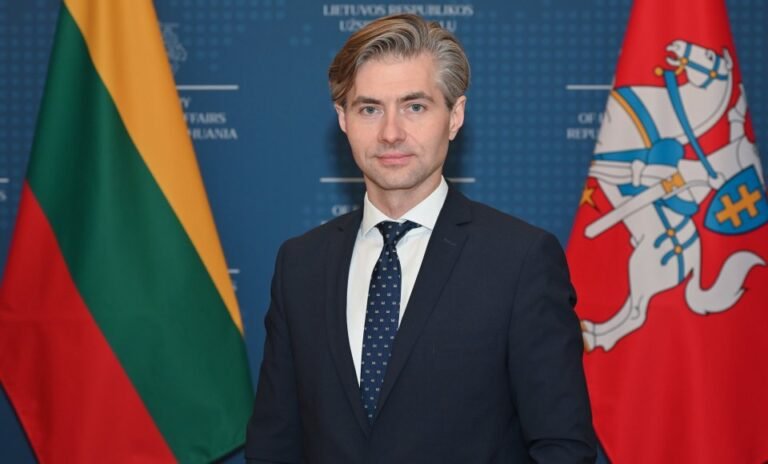With Turkey‘s clearance of Sweden‘s bid to join, approval of detailed defence and deterrence plans, and moving Ukraine closer to membership, 2023 NATO summit in Vilnius delivered significant breakthroughs for the security and stability in the Baltic Sea Region.
At a height of 365 metres, the Vilnius TV Tower is the tallest building in Lithuania. On a clear day, one can see the forests of Belarus from the TV Tower’s observation deck. Upon entering the TV Tower’s sprawling complex, you will see a memorial dedicated to those 14 unarmed civilians – and the hundreds more who were injured – who were killed by the Soviet Army for defending their newly regained independence back in 1991.
The sight of the Vilnius TV tower dominated the skyline of the 2023 NATO Summit in Vilnius. A stark reminder to the leaders of the Alliance that the Russian threat is very real in the easternmost part of the West.
On the map, Vilnius lies just over 30 kilometres from Belarus. A Kremlin ally and a client state. Politically, the countries are light-years away.
After regaining independence, Lithuania, together with the neighbouring Baltic States of Latvia and Estonia, firmly chose Euro-Atlantic integration, joining both NATO and the European Union in 2004. Belarus, under the control of authoritarian dictator, Aleksandr Lukashenko, pivoted his country towards Moscow.
The selection of the host city of the 2023 NATO summit sent a strong message to the world, with Lithuania, Latvia, and Estonia presenting themselves as examples of how the NATO collective security umbrella brings more stability, prosperity, and opportunity to its member states, their businesses, and the people. After the Vilnius summit, more is on the way.
VÄLKOMMEN, SVERIGE. TERVETULOA, SUOMI.
Just a few years ago, pundits on a prime-time Russian propaganda TV depicted a hypothetical situation in which the Kremlin’s infamous “Little Green Men” (Russian special forces with no insignia) took over government buildings in the Baltics, followed by full-scale Russian invasion of the three countries. They then surrounded and forced NATO troops based in Estonia, Latvia, and Lithuania into surrender.
In this frankly absurd scenario, The Russian Air Force proceeded to declare a no-fly zone over the Baltic Sea region, and Russian paratroopers occupied and installed anti-ship and anti-aircraft defences in Götland. What could have been dismissed as a bad joke and mere fantasy at the time, became all too real after Russia’s unprovoked and unjustified military invasion of Ukraine in early 2022.
When news broke on Twitter that Turkey approved Sweden’s membership bid, many observers hailed the decision and suggested renaming the Baltic Sea to “Lake NATO”.
After Finland’s historic accession into NATO earlier this year, Sweden’s accession to NATO was the final missing piece to ensure that a Russian invasion never happens again in the Baltic Sea Region. When news broke on Twitter that Turkey approved Sweden’s membership bid, many observers hailed the decision and suggested renaming the Baltic Sea to “Lake NATO”.
The President of the United States, Joe Biden, remarked on his Helsinki trip after the Vilnius summit that “the decisions we take now are going to determine the course of history for four, five, [or] six decades”. This is no understatement, and Biden’s words were a message to the Finns and Swedes that from this day on, NATO is there for them.
DEFENDING EVERY INCH OF NATO TERRITORY
Another key takeaway from the Vilnius summit was the adoption of NATO’s detailed regional defence and deterrence plans.
It was the first time since the Cold War that NATO allies had to draw up and approve these sorts of plans. Their adoption means that the alliance is ready for any possible escalation scenario and leaves no room for miscalculation for any adversary.
Since Russia’s disastrous invasion of Ukraine in February 2022, Estonian Prime Minister, Kaja Kallas – along with other Baltic leaders – were amongst the most vocal proponents for advocating these new defence and deterrence plans.
With these plans now in place, this is a major long-term strategic win for the Baltic Sea region in terms of security.
Understandably, the details of what these plans include have not been made public. However, Laurynas Kaščiunas, the chair of Lithuania’s national parliamentary security committee, noted that they were specifically drawn up to counter any threat before it even arises and to defend, not to retake, every single inch of NATO territory. The implementation of these plans, especially in the face of economic downturn and rising inflation, present a significant challenge for politicians as they emphasize a major rebuild of Europe’s defensive capabilities. In the Baltic Sea region, it means more troops, more military hardware, and infrastructure.
Estonia and Lithuania already announced plans to create divisions in their respective armed forces. Lithuania will also host a German brigade, but only after it creates all the necessary infrastructure including more training grounds, housing, and schools for the families of Bundeswehr soldiers. This, in turn, is expected to lead to more jobs, more investment, and more opportunities for the local economies of these areas in the long term.
Therefore, now is the time for politicians, businesses, and the peoples of the Baltic Sea region to keep reminding the world of the paramount importance of investing into the security and stability of NATO’s Eastern flank.
The heads of state in the Baltic Sea region are aware that these plans will come with a hefty price tag, and whilst they will have an easier job of selling large-scale defence spending to their respective publics, the same task could prove difficult for fellow NATO members who do not share a border with Russia, or have a collective history of Russian occupation.
Therefore, now is the time for politicians, businesses, and the peoples of the Baltic Sea region to keep reminding the world of the paramount importance of investing into the security and stability of NATO’s Eastern flank.
UKRAINE AND NATO: NOT IF, BUT WHEN
During the recent NATO summit, members agreed that Ukraine would become part of NATO “when allies agree and conditions are met.” Frontier states such as the Baltic States and Poland wanted concrete deadlines and clarity. Other members such as the United States and Germany, wanted more room for manoeuvre.
Pundits and observers hold mixed views on how much of a success the Vilnius summit was for Ukraine, and it must be noted that even last year, it would have been near impossible to imagine that all NATO members would agree to Ukraine becoming a member state.
Diplomats who attended the summit noted that the common understanding amongst member states was that it is a question of “when”, and not “if” Ukraine will join the alliance.
Such a shift in political will in Ukraine’s favour is another major strategic win for the security and stability of the Baltic Sea region.
With Ukraine on track to become a NATO member, the alliance’s easternmost part will become almost impenetrable. Putin wanted less NATO when he invaded Ukraine. He gambled and he lost. NATO is stronger and more united than ever.
For Ukraine, however, the promise of membership in NATO comes with certain preconditions. Major anti-corruption, judicial, and military reforms will need to be implemented, even as the war with Russia drags on into a war of attrition. It would be an extremely difficult task for any country, but time and time again Ukraine has shown remarkable resilience to overcome any challenges. To quote the opening lyrics of the Ukrainian national anthem, “Ukraine is not dead yet.”
After the Baltic States regained their independence from the USSR, it was the Nordic countries that were the most prominent advocates of Euro-Atlantic integration and democratic reforms in Estonia, Latvia, and Lithuania. With ironclad political backing and material support from the Nordics, the Baltic States quickly became modern success stories for democracy.
Ahead of the Vilnius summit, the Foreign Ministers of the Nordic-Baltic Eight (the “NB8” is a regional cooperation format comprising Denmark, Estonia, Finland, Iceland, Latvia, Lithuania, Norway, and Sweden) stated that it is time for the Nordics and the Baltics to do the same for Ukraine.
Politicians and businesses now have a once-in-a-generation opportunity to implement these words.
Politicians and businesses now have a once-in-a-generation opportunity to implement these words.
Furthermore, with Russia’s geopolitical stance severely damaged, all European democracies now have a golden chance to promote democracy even further east into the Caucasus and Central Asia for the sake of a more stable, secure and prosperous world.
AN ALREADY HISTORIC SUMMIT
Because of the gravity of the decisions taken in the Lithuanian capital many NATO leaders have described the Vilnius summit as “historic”. For people of the Baltic Sea region, it is very much that.
During his speech at Vilnius University, President Biden emphasised that he is addressing a “nation and a region that knows better than anyone the transformational power of freedom.”
He added “together, with your brothers and sisters in Estonia and Latvia, you helped end the era of division through the power of connection.”
Today, the states of the Baltic region have a historic chance to enhance existing and forge new connections. Maybe in forty, fifty, or sixty years from now the future generations will say that it all started in Vilnius.
The writer Vytautas Matulevičius is an experienced communications professional who is the managing partner of Bosanova, a Lithuanian communications agency. Miltton and Bosanova have partnered up to help our clients on an even broader scale.
Source: Miltton.com.























One Response
Big event in Vilnius indeed.